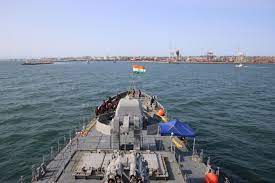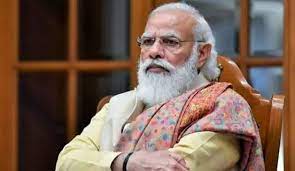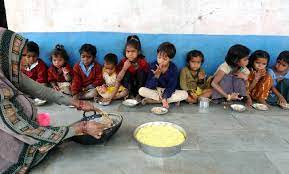Today Current Affairs: 14th October 2022 for UPSC IAS exams, State PSC exams, SSC CGL, State SSC, RRB, Railways, Banking Exam & IBPS, etc
Table of Contents
IBSAMAR VII:

INS Tarkash reached Port Gqeberha (also known as Port Elizabeth), South Africa to participate in the seventh edition of India-Brazil-South Africa Maritime (IBSAMAR) i.e., IBSAMAR VII.
- IBSAMAR is an important part of IBSA trilateral defence cooperation.
IBSAMAR VII:
- It is a joint Multinational Maritime Exercise between the Indian, Brazilian and South African Navies currently being held in South Africa from 10-12 October, 2022.
- The previous edition of IBSAMAR (IBSAMAR VI) was conducted in Simons Town, South Africa in 2018.
- The Indian Navy is represented by the Teg class guided missile frigate, INS Tarkash, a Chetak helicopter and the personnel from the Marine Commando Force (MARCOS).
- The harbour phase of IBSAMAR VII includes professional exchanges such as damage control and fire-fighting drills, Visit, Board, Search, and Seizure (VBSS)/cross boarding lectures and interaction among special forces.
- The Joint Maritime Exercise will strengthen maritime security, joint operational training, sharing of best practices and building interoperability to address common maritime threats.
Prime Minister’s Development Initiative For North East Region (PM-DevINE):

The Union Cabinet approved a new Scheme, Prime Minister’s Development Initiative for North East Region (PM-DevINE).
- PM-DevINE was announced in the Union Budget 2022-23 to address development gaps in the North Eastern Region (NER).
- It is a Central Sector Scheme with 100% Central funding.
- The new scheme, to be implemented during the remaining four years of the 15th Finance Commission from 2022-23 to 2025-26 have an outlay of Rs.6,600 crore.
- The PM-DevINE is in addition to the quantum of resources available for the development of the NE region. It will not be a substitute for existing central and state schemes.
- The scheme will be implemented by the Ministry of Development of North Eastern Region through North Eastern Council or Central Ministries/ agencies.
- Objectives:
- Fund infrastructure convergently, in the spirit of PM Gati Shakti
- Support social development projects based on felt needs of the NER
- Enable livelihood activities for youth and women
- Fill the development gaps in various sectors
What Is Public Private Partnership Model?

The railway ministry is planning to bid out 16 stations under the public-private partnership (PPP) model. These railway stations will be upgraded to ensure improved basic facilities and accessibility for passengers.
- This is in addition to the 1253 railway stations that have been identified for development under the Adarsh Station Scheme.
Public Private Partnership Model:
- It is an arrangement between the government and private sector for the provision of public assets and/or public services.
- Public-private partnerships allow large-scale government projects, such as roads, bridges, or hospitals, to be completed with private funding.
- In this type of partnership, investments are undertaken by the private sector entity, for a specified period of time.
- As PPP involves full retention of responsibility by the government for providing the services, it doesn’t amount to privatization.
- There is a well-defined allocation of risk between the private sector and the public entity.
- The private entity is chosen on the basis of open competitive bidding and receives performance-linked payments.
- PPP route can be an alternative in developing countries where governments face various constraints on borrowing money for important projects.
- It can also give required expertise in planning or executing large projects.
Multi-State Cooperative Societies (Amendment) Bill, 2022:

The Union Cabinet has approved the Multi-State Cooperative Societies (Amendment) Bill, 2022.
- It seeks to amend the Multi-State Cooperative Societies Act, 2002.
- The Bill will incorporate the provisions of the 97th Constitutional Amendment.
- The amendments have been introduced to improve governance, reform the electoral process, strengthen monitoring mechanisms and enhance transparency and accountability.
- The Bill also seeks to improve the composition of board and ensure financial discipline, besides enabling the raising of funds in the multi-state cooperative societies.
- It has included provisions relating to representation of women and Scheduled Caste/Scheduled Tribe members on the board of multi-state cooperative societies.
- It has provisions for setting up of Cooperative Election Authority, Cooperative Information Officer and Cooperative Ombudsman.
- There will also be a provision for issuing non-voting shares in multi-state co-operative societies to help them raise funds.
- The Multi-State Co-operative Societies Act, 2002 was enacted with a view to facilitating democratic functioning and autonomous working of multi-state co-operative societies in line with the established co-operative principles.
- India has more than 1,500 multi-State co-operative societies serving as an important tool to promote economic and social betterment of their members based on the principles of self-help and mutual aid.
Suposhit Bharat Initiative:

According to the Ministry of Women and Child Development, more than 15 crore activities were conducted on various themes across the country during the 5th Rashtriya Poshan Maah from 1st to 30th of September contributing to the Prime Minister’s vision for a Suposhit Bharat.
- Through the Suposhit Bharat initiative, the government intend to conceptualize, develop, pilot and scale up food-based nutrition interventions through food services at institutional food services’ level, and street foods, school & college canteens.
- This will therapeutically address malnutrition and non-communicable diseases in the general population.
- POSHAN Abhiyaan is a multi-ministerial convergence mission with the vision to ensure attainment of malnutrition free India.
- POSHAN Abhiyaan provides a platform to converge the activities of various stakeholders towards attaining the goal of ‘Suposhit Bharat’.
Inflation:

According to the data released by the National Statistical Office (NSO), retail inflation accelerated to a five-month high of 7.41% in September, 2022 from 7% in August, 2022 as food inflation surged sharply to 8.41% last month the steepest level in 22 months.
- September’s retail inflation was the highest since April, when price rise quickened to an almost eight-year high of 7.79%.
- This is the ninth month in a row that inflation has exceeded the 6% upper tolerance threshold mandated for the RBI and would require it to send an explanation to the government on its inability to achieve the price stability target.
- Rural inflation picked up further steam, from 7.15% in August, to touch 7.56% in September, while urban consumers also experienced a resurgence in price rise at 7.27%, from 6.72% a month earlier.
- Inflation in cereals quickened to 11.5%, with rural India facing almost 12% price gains, up sharply from 9.6% in August and almost doubling from July’s 6.9% pace.
- Vegetables’ inflation almost virtually doubled over two months, from 10.9% in July to 18.1% in September, with urban consumers facing a sharper 20.1% rise.
World Sloth Bear Day:

The first World Sloth Bear Day was observed on October 12.
- It aims to spread awareness about protection and conservation of sloth bears.
- A proposal for observing the World Sloth Bear Day was mooted by Wildlife SOS India, an organisation involved in sloth bear conservation and protection for over two decades and the IUCN-Species Survival Commission sloth bear expert team accepted the proposal and declared the day to be celebrated worldwide.
Sloth bears ( Melursus ursinus):
- Sloth bears are endemic to the Indian sub-continent with small populations in Nepal and Srilanka and 90% of the species population is found in India.
- They are classified as ‘Vulnerable’ on the IUCN Red List.
- They are identified by their very distinct long, shaggy dark brown or black fur, distinct white V-shaped chest patch and four-inch long ivory-coloured curved claws used for digging out termites and ants from rock-hard mounds.
- Listed under Schedule I of the (Wildlife Protection) Act of India, 1972 the species has the same level of protection as tigers, rhinos and elephants.
- They are found in all parts of the country except Jammu and Kashmir and north-eastern States.




